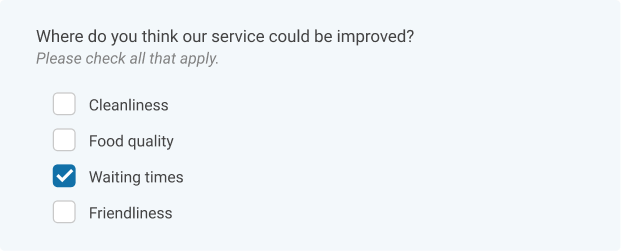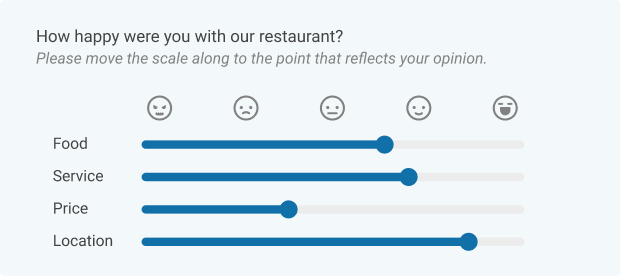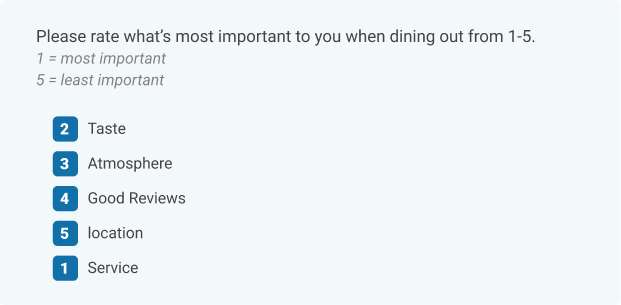Closed Questions Explained

When conducting any form of research, considering the way questions are structured is essential. Carefully designed questionnaires that use the appropriate type of questions are often the key to collecting data successfully. There are broadly two types of questions in research: closed questions and open questions. In this guide, we will explain how closed (aka “close-ended”) questions are used to effectively gather data.
We’ll look into the differences between open questions and their closed siblings, as it’s important to understand how the two approaches differ. We’ll also give some real-world examples of closed questions, and explain when closed ended questions should be used.
What is a closed question?
Closed questions collect quantitative data. They give the respondent a limited amount of options to choose from. They are popular, as quantitative data is easier to analyse than qualitative data.
There are a few versions of close-ended questions, such as those that only allow “yes” or “no” answers, or “correct” or “incorrect” answers to statements. These are classed as dichotomous questions. Alternatively, multiple choice questions are also by definition closed, as response options are limited and respondents must select from a list of choices.
Open vs. closed questions
Open ended questions provide in-depth insights to user behaviour and opinions. This is because the respondent has the opportunity to answer the question freely. They are not restricted to answering from a few limited choices, like with closed questions. Instead, they can write out their answer and explain their reasoning. This is considered to be qualitative data.
While some projects are better suited to closed ended questions, there is always some level of value in open questions. This is because they can provide quality answers, where respondents elaborate on their feelings. Open ended questions provide detailed evidence as to what the consumer wants or expects. However, you may have no way of evaluating these written answers in a proportional way. This means the data is then impractical to analyse.
Closed ended questions, on the other hand, limit the respondent to a predetermined list of response options. Unlike open questions, which open a window for ongoing discussion, closed questions elicit controlled responses.
Examples of closed questions
There are a few ways that close ended questions can be structured. These examples provide a variety of questions that illustrate how different types of closed questions can be formatted. For context, we’ll imagine we are running a hospitality survey with questions regarding a restaurant service.
Multiple choice questions
Multiple choice questions can be designed in a few ways. They often involve the use of scales, as this helps to assign a numerical value to each possible selection. Here are examples of each type of multiple-choice question.
Checklist:
This is where respondents have the option to select the specifics that apply from a list of options. The researcher can then determine how many participants ticked each option and figure out where they should improve on service from there.

Likert scale:
Likert scales are very easy to use, as the respondent can visually determine just how much they feel about a certain topic. For the researcher, there is usually a number assigned to each option.
For example, the happiest face might be assigned the number 10, while the unhappiest face is 0. This means they can then calculate how happy customers were with each aspect of the restaurant, by adding up the values of each respondent.

Rating scale:
This is where the respondent rates how they feel about something, usually on a scale of 1-5. Reviews usually use rating scales.

Rank order:
This multiple-choice question allows respondents to assign a value to a specific list of options. When translating rank order data into a graph or chart, researchers can use these numerical values to do so.
In this example, the researcher would be able to determine which option is most important to customers by adding all the values associated with each option. They could then see which option had the lowest total score – this would be the most important aspect of dining out for the selection of participants that responded.

Dichotomous questions
Dichotomous questions will give two options. They can include yes or no answers, to true or false statements. Dichotomous questions are the easiest for customers to answer, however they may feel limited with their options and wish to explain their choice further.
This is where open questions are perhaps a good choice. In this example, the researcher could open up further discussion by adding a section that says: “Please explain why?”

Advantages of closed questions
Many researchers find using closed-ended questions to be advantageous over open-ended questions. The major advantage of close-ended questions comes down to one simple detail – closed questions collect quantitative data. Quantitative data is data that is numerical, and can therefore easily be turned into percentages, charts, and graphs.
Here are the main benefits of close ended questions:
- Data from closed questions can be interpreted into graphs, charts and percentages:
This gives researchers a visual insight into consumer behaviours and thoughts. - Closed questions save time and money:
Analysing qualitative data into numerical (quantitative) data takes up a lot of time and resources. Primary research can be costly, so closed questions are often the preferred choice. - Closed ended questions are easier for respondents, too:
Having limited options to answer with means participants aren’t overthinking their responses. Closed questions are also easier to understand, as they’re usually worded in simpler terms. - Data from close-ended questions can be easily compared and sorted into categories:
This helps with the analysis of data. It can therefore help researchers make well-informed conclusions that are backed up by the research.
When to use closed questions
Determining which type of questions to use can get complicated. First, you need to consider the reasons behind designing your questionnaire. You should use close-ended questions if:
You want to convert opinions or behaviours into numerical data
Open questions leave a lot of room for useless information. Instead, you can ask them to rate a product (for example) on a scale of 1 – 10 (a closed ended question). By using the close-ended question option, you are allocating each opinion with a number. This enables you to analyse data clearly.
You want to collect reliable, consistent data
Closed questions allow you to choose the responses that can be made by participants beforehand. This means you are prompting participants to be specific in their answers, giving clear results.
You have a large number of participants
If everyone responded with written, descriptive opinions, insights would become so jumbled they’re basically worthless. In large studies, involving a sizeable sample size, using close ended questions can help you analyse and stratify data with ease.
In conclusion
Conducting any form of research involves coming up with suitable methodologies. Selected approaches should support the ease of collecting data. Where questionnaires are concerned, the way questions are designed is a crucial consideration. Closed questions are a great, reliable way of collecting large amounts of quantitative data that can then be organised and analysed with ease.
Despite this, open questions can provide very valuable information. Perhaps the respondent has a concern that cannot be explained within a closed question. In these cases, open questions can be beneficial, as they provide deeper insights. However, close-ended questions are much easier to quantify and analyse. If you have a limited time frame or budget, closed ended questions may be the better option. Closed questions can also provide more reliable, conclusive data.
Whether you use closed, open, or a mixture of both styles of questions will depend on the type of data you’re trying to collect. Always consider the expectations you have for the outcomes of your research, before deciding which type of questions to use.